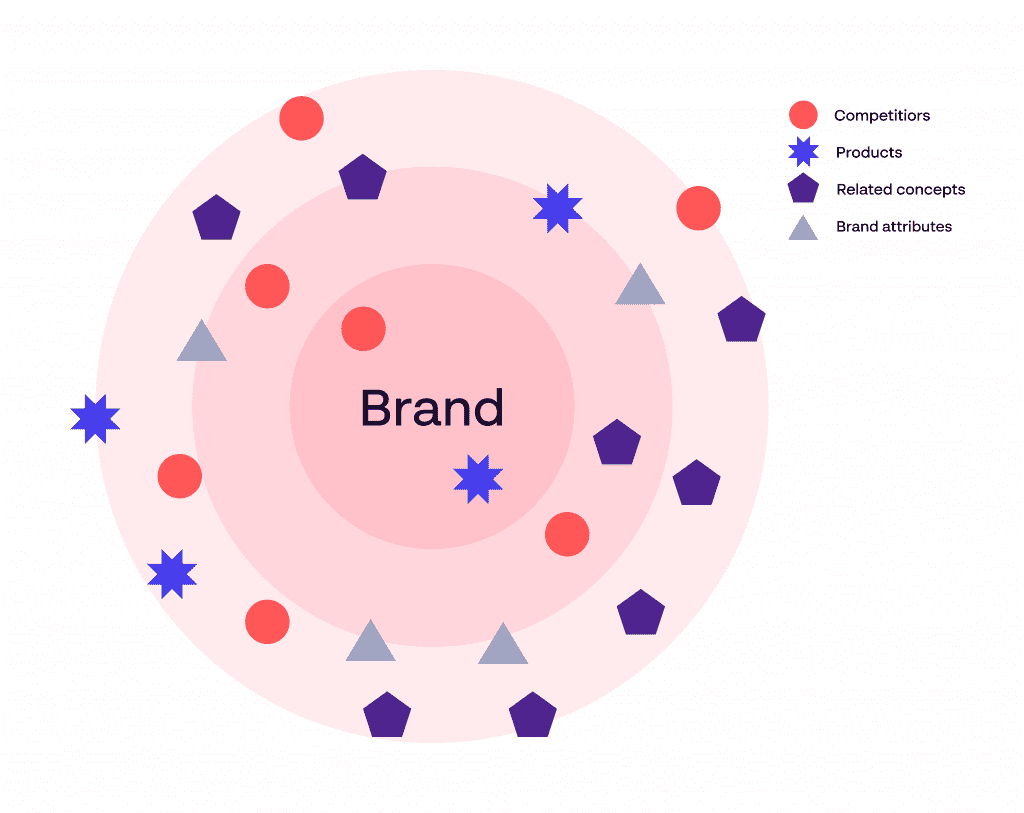Ever wondered why certain brands spring to mind at the thought of particular words, places, times of the year, or even people? It may seem natural, but in most cases, it’s something that they have spent years establishing through daily interactions and significant moments in our lives.
Brand associations are what create the link between a brand and thoughts or concepts.
They influence our buying habits and help us decide what makes one brand different from another — even when the products and services they offer are largely the same.
What’s the science behind it?
How brand associations affect the inner-workings of our minds goes deep into psychology.
The most widely recognised scientific explanation is found in the Hebbian Theory, developed by ‘the father of neuropsychology’, Donald Hebb. In The Organisation of Behavior (published in 1949), Hebb outlines his work in trying to explain how learning is accomplished within the brain.
Part of his theory is that neural pathways are developed based on experiences and that, when certain connections are created more frequently, they become faster and stronger. Hebb also theorised that one thought would be more likely to cause another if they have been recalled at the same time on multiple occasions in the past.
Brands can build these connections through:
Attributes
The distinguishing features of a brand’s products or services could include physical appearance, feel and quality, as well as packaging and presentation.
For instance, a brand looking to promote that they are “eco-friendly” could build this association by ensuring their products are recyclable, or designing their packaging with colours and themes that represent nature.
Attitudes
The attitudes we have towards brands can be a direct link or very abstract. They can create feelings and emotions, such as happiness or nostalgia, or be linked to specific lifestyles, like athletics or luxury.
Sticking with the theme of nostalgia, adverts like this one from Microsoft from 2013 illustrates how brands can evoke the past through experiences, trends and objects, and then tie this back to their own company’s story. Finding ways to link familiar, recognisable elements for your customers to your brand values is an effective way to drive connections.
Benefits
The benefits that you associate with a brand could be linked to the reasons you buy their products or services, or the experiences you have while using them.
They might also align with your personal values by contributing to social causes. Examples like Warby Parker’s pledge to donate a pair of glasses to children and those in need for every pair purchased are illustrations of how choosing their brand helps you make the world a better place.
Celebrities
Brands have been using famous ambassadors to endorse their products for years. It’s also becoming more common to see company founders gaining publicity and having a major influence on brand association (think Steve Jobs, Richard Branson and Elon Musk).
This works most effectively when brands pinpoint a celebrity that embodies the values of your brand, for example, Ed Sheeran’s collaboration with Heinz was all the more effective because of Sheeran’s love of their ketchup, even having a tattoo of a bottle on his arm!
How the world’s leading brands stay front-and-centre
For the global brands battling it out to become the leading name in their market, establishing and maintaining positive brand associations is crucial. It’s the reason that:

Whether it’s bringing in the holiday season or evoking nostalgia with its iconic glass bottles, Coca-Cola is a brand that feels timeless. Positive brand associations make Coca-Cola seem as if it has been sharing happiness since forever.
There’s a reason you’ll find bright red Coca-Cola branding at holiday resorts, sports events, and tied to beloved characters like Santa Claus. By ingraining itself in these overwhelmingly positive experiences, the brand will have consumers reaching for its product in the good times and the bad to rekindle fond memories.

Apple hasn’t just gained customers, it’s garnered a following. We recognise their products as revolutionary, and this was only amplified by the success of their branding:
- The sleek design of their products and the packaging they are presented in makes their range feel cutting-edge and premium
- Apple product launches are special events that the brand has always done a standout job building anticipation for, making every new development feel like a true game-changer
- Their ties to iconic innovators like Aardman Animations in their “Behind The Mac” series tie their brand and products to people who transformed their industry

The Nike swoosh has long been associated with the world’s best performing and most famous athletes. The brand’s past and present ambassadors have similar personality traits that align with its marketing — ambition, dedication and an unstoppable drive to be the best.
As well as tapping into athletes’ aspirations, Nike has aligned itself with the emotions that first draw people into sport, such as competitiveness, teamwork, self-improvement and determination. Not only are consumers seeing Nike and thinking of sport, they are seeing sport and thinking of Nike.

When you think of Starbucks, as well as the expansive range of coffees available and that iconic mermaid on their logo, something that springs to mind is the writing of customers’ names on their cups.
While that may not feel like a big deal on the surface, this encouraged people to share their personally branded cup of coffee on their social channels. This little touch of customer engagement quickly made Starbucks a standout influencer brand on platforms like Instagram, and they continue to connect with millions across the globe this way.

After a run of negative publicity surrounding childhood obesity, McDonald’s’ long-running mascot, Ronald McDonald, was the first to disappear from their advertising. But rethinking their marketing strategy was just the beginning. They:
- Revamped their menus to incorporate healthier options, with the nutritional information of meals included on these
- Drastically altered their brand colours to green and introduced recyclable packaging to project a strong eco-friendly message
- Reused their own cooking oils to fuel their bio-diesel range of trucks
- Overhauled the design and feel of their interiors to encourage more people to eat in the restaurant rather than stick to takeaways
3 ways to start building stronger associations
If building positive brand associations isn’t already part of your ongoing strategy, then these key takeouts will help get you back on track.
#1 Association mapping
A brand association map like the example below will help you analyse the positive and negative associations that consumers currently have of your brand. It will show you where you stand out from your competitors and what makes your customers choose your products or services.
You can use this information to focus on areas where you can infuse new meaning, generate engagement and create connections. The areas you choose to establish will then feed into how you shape your marketing strategy for the future, and how your content is distributed within this.

#2 Analysing search terms
When people search for something on Google, they will often try a combination of terms or phrases. This ‘co-search’ data can be analysed to find out the mental connections people are making based on topics, products, solutions and more.
As well as revealing whether your brand positioning lines up with what people are really searching for, co-search analysis can also highlight opportunities to build new associations based on your results.
In addition, investing in social listening tools takes the same principles of co-search data, only in real-time. By keeping your finger on the pulse of what’s generating buzz on social media platforms, you can build a strong sense of what people are linking your brand to and hot topics that you can harness for upcoming content.
#3 Avoiding the negatives
Even with the best intentions, it’s all too easy to cause or strengthen negative associations with your brand. Some of the most common mistakes are:
- Inconsistencies – Whether it’s the quality products, customer service or brand assets, staying consistent is vital for keeping on top of customer expectations. When trust in brands is at a low, negative memories are more likely to come out as the stronger association.
- Going against your own brand values – In Nike’s own brand association map, their use of sweatshop labour has a stronger association than their sponsorship of school sports teams. This is a lesson in ensuring that the values you promote to consumers align with your ethical practices as a company.
- Forcing connections that just don’t fit – It’s important for brands to react to what’s going on in the world. However, attempting to raise brand awareness via trending topics without being part of a solution or taking a stance that feels genuine puts your brand at risk of being ‘called-out’ by consumers on social media.
Strengthen your brand, connection by connection
Building positive associations that reach the hearts and minds of your audience is an ongoing process, and one of the most powerful marketing techniques at your disposal.
With a solid understanding of what consumers already associate with your brand and a clear focus on where you need to stand out from your competitors, you can tap into human nature, influence behaviour and build a brand identity that stays front-and-centre for years to come.
However, sustaining the connection between your brand and consumers relies on content that is both consistent and ongoing. Falling short on either of these key traits can gradually undo the hard work you’ve invested in forging those bonds to your customers.
BAM by Papirfly™ is helping brands across the globe steer clear of this scenario. By enabling marketing teams to generate more content in-house faster and more cost-effectively – with no sacrifice of quality or brand consistency – brands can build and maintain the connections they establish with their audience better than ever before.
Empower your team. Enhance your branding. Get in touch and discover BAM today.
